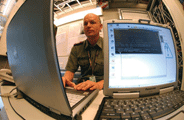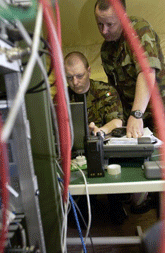It's not as easy as it sounds: Migrate applications and services to Internet protocol and reap the benefits of a single, unified network backbone. For one thing, your agency probably has legacy systems it's not ready to discard (or port to a new platform). And if it doesn't, chances are there's another agency you work closely with that does.Sometimes, it's this cross-organizational challenge that presents the biggest hindrance to effectively utilizing converged IP networks. The Defense Department knows this better than most, and the lessons it has learned could serve other agencies well.In May, the U.S. European Command got together in Germany with 40 of its allies for a two-week exercise testing the interoperability of systems used in humanitarian and peacekeeping operations.Combined Endeavor 2006, the 12th Partnership for Peace interoperability exercise, illustrates the military's global move toward a common IP infrastructure, a linchpin in its larger network-centric operations initiative.'We try to anticipate what is going to be required in the field,' said U.S. Army Lt. Col. Joseph Angyal, the exercise director. 'We're getting better at it.'What's required, those involved say, is the ability to tie together applications that more often ride on IP networks. Moving systems to IP is one thing; making them work together once there is another.'We are focused solely on testing and documenting the systems that are deployed or are about to be deployed,' Angyal said. 'We aren't experimenting. It covers the entire gamut'voice, video and data in all forms.'There still is plenty of legacy equipment that must be accommodated to enable intercommunication with joint multinational forces in the field. But more and more, the IP backbone is emerging as a standard element.'At the transmission layer, I think we are becoming more alike,' Angyal said. 'At the application layer, that's where the problems lie.'The disparity in applications is, in part, a legacy of the Cold War. In 1995, when the first Common Endeavor exercise was held, equipment either was Warsaw Pact-compatible or NATO-compatible. That distinction has not completely disappeared.'That's the reality of deployment nowadays,' Angyal said. 'It is traditional and nontraditional equipment.'The differences are also a function of tight budgets, said Tom Cooper, NATO defense initiatives manager for Cisco Systems Inc.'Things that are 30 years old and still work, they want to keep,' Cooper said.Cooper, a former Navy captain, has been involved with Common Endeavor since the exercises began in 1995. Because Cisco equipment is a common denominator of many of the systems tested in Common Endeavor, the company provided the backbone for the exercise.The purpose of Common Endeavor is simple, Cooper said. 'Bring equipment you have deployed to one location, we'll hook it together and see how it works.'When the exercises began, some organizations were still using hand-cranked telephone switches. The focus of the tests was on circuit-switched networks with time division multiplexing (TDM). This year, most of the equipment is IP, although the environment remains mixed.'Now we are up to the latest IP equipment, and we are still trying to make sure it will work with the legacy equipment,' Cooper said. 'Does it work together, or do we have to provide some kind of interface to make sure it will work?'Many of the thousand tests scheduled for this year focus on voice over IP, which Patrick M. Ryan, a 26-year Air Force veteran and Cisco's director of defense initiatives, called a disruptive technology. VOIP is often the poster child of converged IP network programs.Ryan said the time to market for VOIP has been less than anyone had expected. 'Even though it's been years,' he said, 'it's been quick for a technology change.'The military may actually be ahead of the curve in adopting VOIP. DOD's Joint Interoperability and Test Command has for years been running a certification program to help ensure VOIP products meet interoperability, performance and security requirements. But government's take on VOIP is likely different than the commercial sector's.A study of 390 U.S. businesses by the Parsippany, N.J.-based research firm Telecom Intelligence Group found that only 41 percent had begun implementing VOIP. The percentage was greater among larger organizations, 57 percent in companies with more than 500 employees compared with only 29 percent for smaller companies. But only 15 percent of the companies surveyed said they were implementing IP telephony applications to take full advantage of VOIP.'There is a significant gap between the percent of U.S businesses that believe IP telephony can change the way they do business and the percent that are actually achieving business value from IP telephony,' the study concluded.The move to VOIP is now seen as inevitable, said Terry White, the senior program director for the Telecom Intelligence Group.'It reached the point several years ago of becoming 'when,' not 'if,' ' White said.The delay in adopting IP telephony (as opposed to just VOIP) can't be pinned on reliability or voice quality issues any longer. 'Those issues have been resolved,' White said. 'Ultimately, it's about a more robust set of applications.'IP telephony applications such as unified messaging, multimedia conferencing and collaboration, presence management and teleworking are seen as boosting productivity. Businesses consider productivity a 'soft benefit' and are more likely to deploy applications that can produce hard savings.But better productivity is exactly what military organizations'and many government agencies'are looking for in IP applications. Low budgets make fewer forces available, and IP networks are seen as a force multiplier. And DOD wants them sooner rather than later, meaning large-scale interoperability testing is mandatory for a smooth move to IP.'Ease of deployment is critical,' said Ryan. 'The timeline for moving information is more critical than it has ever been.'Voice, once the primary means of military communications over radio channels, is now only one option in the communications toolbox, along with video, graphics, e-mail, text chat and data files.'You can now plug in voice as a tool in the equation, as appropriate,' Ryan said.Earlier this year, the Defense Information Systems Agency turned to AT&T Government Solutions Inc. and Northrop Grumman Mission Systems to build an IP-based network that could carry videoconferencing applications as well as voice services across multiple continents. The network was originally intended for administrative communications, but as technology has evolved, it morphed into a command and control system.IMGCAP(2)Still, DOD and others will tell you that moving to IP depends on various factors, not the least of which is the sensitivity of information that will travel over the network. Another crucial factor remains cost.NATO is working toward a single, all-IP network. But neither NATO nor any individual country is fielding a unified, all-IP infrastructure, and the move to IP communications is being done piecemeal.'Most nations' militaries are budget-limited and can't do wholesale change-outs,' Ryan said.Financial constraints also are putting a premium on off-the-shelf technology.'No one has the budget to build everything they want, so when possible, they are buying it rather than building it,' Ryan said.'All of the nations continue to build IP capability,' Angyal said. 'Some are really taking leaps forward in the technology they possess and the ability to use it. Estonia completely skipped a generation.'But policy does not always keep up with operations.'The operational world is doing a fantastic job of using IP to its best capabilities,' Ryan said. But acquisition rules and procedures have not kept up. 'There is a natural resistance to change.'Angyal agrees about the challenges in moving military forces to new infrastructures.'From a technology perspective, the pieces are there to do that,' he said. 'The impediment is in the policy. And policy is harder to influence, because it's made at a much higher level.'The expense of tying all of this equipment together makes exercises such as Common Endeavor critical to successful deployment.'The primary cost is integrating systems, not buying and using them,' Ryan said. 'The key is to do it from an enterprise environment.'The exercise is producing a valuable database on how to integrate the equipment used by the Partnership for Freedom forces.'We have about 12,000 after-action comments now,' Angyal said. 'We'll add another 1,200 this year.'No matter how far the partnership moves toward standardizing on off-the-shelf IT technology, integration with legacy equipment will remain a challenge.'There will always be a valid concern for the survivability of your systems,' Ryan said. 'You don't want all of your eggs in one basket. I don't think that TDM will ever go away completely.'
Finnish Army Staff Sgt. Jouni Hussoto reviews a telephone connection plan.
Airman 1st class Josie Kemp
Irish Defense Force's Signalman Karl Deegan and CPL Dermot Doran test Internet Protocol over fiber optics during Combined Endeavor 2006.
Airman 1st class Josie Kemp








